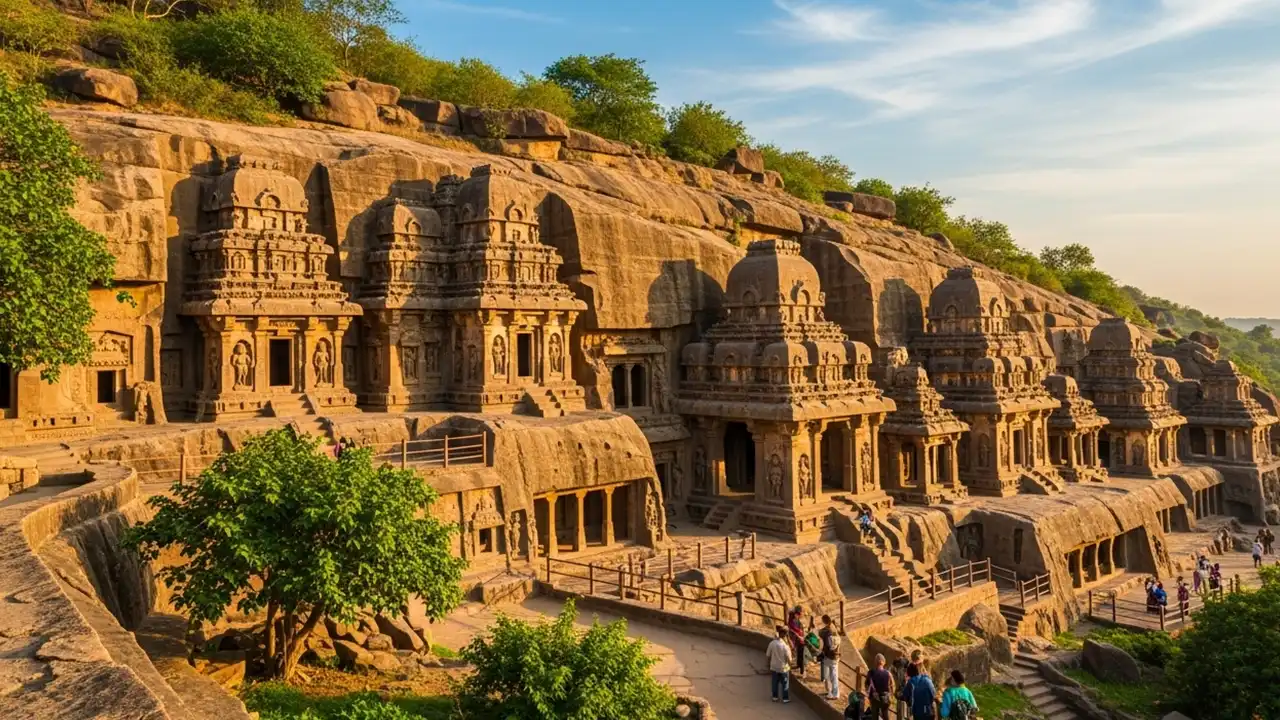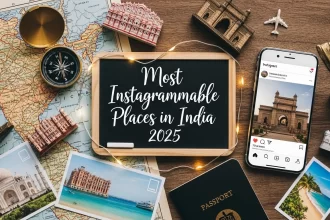India is a country rich in history and unique architectural grandeur. In true grandeur, nothing is more amazing than the rock-cut temples – massive structures cut directly from a solid rock face, versus building them from brick and mortar. These are not just objects; these are achievements of design, engineering, devotion, and creation that carved the mountains into holy places.
You will get a full experience if you are interested in ancient wonders, amazing design, and powerful spiritual places. You will remember these Indian rock-cut caves. Get ready to go back in time as we take a look at 12 amazing rock-cut temples in India that you will never forget.
Why Rock-Cut Temples Are So Unique
These are not conventional temples. Rock-cut architecture represents a distinct phase in the evolution of temples in India, and it displays remarkable skill and creativity. Think of artisans starting at the top of a rock face and carving down over many months or even years to create expansive chambers, intricate carvings, and tall, spiraled pillars. It’s a backward construction, whereby material is removed as opposed to being built up.
Architectural Wonder: Witness a level of engineering from hundreds of years in the past that is no less than impressive.
Artistic Wonder: Observe stunning carvings, murals, and sculptures that are unrivaled.
Spiritual Wonder: Feel the serene and majestic quality of one of the oldest forms of places of worship.
Historical Wonder: Explore the rich cultural and religious stories they preserve.
12 Incredible Rock-Cut Temples
This is a great list of India’s most incredible rock-cut temples, and you should put them on your travel bucket list!
1. Ajanta Caves, Maharashtra
Significance: A UNESCO World Heritage Site, the Buddhist rock-cut caves were created between the 2nd century BCE and about 480 CE. These caves are mainly known for their stunning mural paintings and frescoes that illustrate the Jataka tales (stories about the previous lives of the Buddha) and Buddhist deities.
Reasons for Visiting: An unmatched collection of ancient Indian art and architecture, and the bright colors and dynamic figures bring life to the cave walls.
Key Points: Buddhist monasteries and prayer halls; world-famous murals; rich narrative of history.
2. Ellora Caves, Maharashtra
Significance: Another UNESCO World Heritage Site, Ellora has caves dedicated to Buddhism, Hinduism, and Jainism, which are representative of the religious harmony present in Ancient India, from the 6th to 10th centuries CE.
Reasons for Visiting: It has the Kailasa ‘Cave 16’ in the furnace of rock, an amazing monolithic carved top-down structure representing Mount Kailash, and it is an amazing feat of engineering, carved out of a single rock.
Key Points: Multi-religious complex; Kailasa ‘Cave 16’- a monolithic wonder; a wide variety of carvings and sculptures.
3. Elephanta Caves, Maharashtra
Significance: The Elephanta Caves are a UNESCO World Heritage Site made up of rock-cut Hindu caves on an island in the Mumbai Harbor, dating to the 5th to 8th centuries CE, which are almost completely dedicated to Lord Shiva.
Reasons for Visiting: The Elephanta Caves are exceptionally well known because they feature a 20-foot high sculpture of Trimurti, which depicts Shiva as Creator, Preserver, and Destroyer. The scenic aspect of the caves being on an island is an added incentive to visit the Elephanta Caves.
Key Points: Island; colossal; Shiva sculptures; Trimurti; ferry-boat from Mumbai.
Must Read: Monsoon Magic at Matheran A Vehicle-Free Hill Station of Maharashtra
4. Karla Caves, Maharashtra
Significance: The Karla Caves are dated to the 2nd century BCE, are among the oldest, and are among the best examples of rock-cut architecture from Buddhism in India.
Reasons for Visiting: The Karla caves have the largest and probably the best preserved chaitya hall (prayer hall) in India. There are also impressive stone pillars surrounded by carved panels that add to the magnificence of the hall. The scale and quality of workmanship also stand out.
Key Points: Largest Buddhist chaitya; ancient wooden beams (original); grand stone pillars.
5. Bhaja Caves, Maharashtra
Significance: The Bhaja Caves represent an ancient example of rock-cut Buddhist caves dated to the 2nd century BCE, and they are essentially contemporary with the Karla Caves.
Reasons for Visiting: The Bhaja Caves have stupas (reliquary mounds) that are particularly noted in the chaitya hall, and there are some very unique wooden architectural elements. Additionally, some waterfalls occur during the monsoon season, which adds to the grandeur of the setting.
Key Points: Early examples of Buddhist architecture; chaitya hall with stupas; unique wooden architectural elements; waterfalls during the monsoon season.
6. Badami Cave Temples, Karnataka
Significance: These Hindu, Buddhist, and Jain cave temples, originally carved from sandstone cliffs and dating back to the 6th century, reflect the earliest examples of the Chalukyan architectural style. Badami was the capital of the Chalukyan dynasty.
Reasons for Visiting: The caves are renowned for their colourful murals, detailed sculptures, and the beautiful views across Agastya Lake in the valley below. Each cave has an alternative religious discourse.
Key Points: Chalukyan architecture; sandstone carvings; Hindu, Buddhist, Jain caves; views of Agastya Lake.
7. Undavalli Caves, Andhra Pradesh
Significance: A group of four major caves, mainly rock-cut, near Vijayawada. All but one cave is a Hindu cave dating back to around the 4th to 5th century CE (the other cave being a converted Buddhist monastery).
Reasons for Visiting: Famous for the four-storied cave housing a large reclining Vishnu statue carved out of a single piece of granite slab. The caves are also a good representation of Gupta-period rock-cut art.
Key Points: Four-storied cave; giant reclining Vishnu statue; early rock-cut art; peaceful setting.
Must Read: Andhra Pradesh and Telangana Ancient Hanuman Temples
8. Udayagiri Caves, Odisha
Significance: The Udayagiri Caves are near Bhubaneswar; partially natural and partially artificial Jain rock-cut caves were developed, mainly under King Kharavela, from the 2nd century BCE.
Reasons for Visiting: Renowned for the Hathi Gumpha (Elephant Cave) inscription, an important historical source, and Rani Gumpha (Queen’s Cave), a double-storied monastery with stunning sculptures.
Key Points: Ancient Jain caves; historic inscriptions (Hathi Gumpha); sculpted figures (Rani Gumpha).
Must Read: 6 Must-Visit Holy Sites in Puri For Jagannath Rath Yatra
9. Masrur Rock-Cut Temple, Himachal Pradesh
Significance: A Unique complex of 15 monolithic Shiva temples carved from a rock, all from the 8th century CE. Often referred to as the ‘Himalayan Pyramids’.
Reasons for Visiting: The Only rock-cut temples in north India demonstrate astounding Nagara-style architecture. The carvings are awe-inspiring. There is a unique visual effect of the reflection of the temple in the nearby pond.
Key Points: Only north Indian rock-cut complex; Nagara style; monolithic temples; ‘Himalayan Pyramids’ nickname.
Must Visit: Yulla Kanda: Best Time & A Pilgrim’s Guide to a Spiritual Trek in Himachal Pradesh
10. Amarnath Cave Temple, Jammu & Kashmir
Significance: Considered one of the holiest Hindu pilgrimage sites (above 2,700ft), this cave is known for the natural ice lingam of Lord Shiva that forms each year. It’s not a rock-cut site as it is a natural formation, but not carved by hands in the traditional sense; it is regarded as a manifestation of the divine in a cave.
Reason for visiting: You will have to endure a tough pilgrimage to experience a natural wonder that is believed to be Lord Shiva himself. You will feel the spiritual devotion.
Key Points: Natural Ice Lingam; high-altitude pilgrimage; annual Divinity manifestation; extreme spiritual significance.
Must Visit: Amarnath Yatra 2025: Routes, Dates, Age Limit and Your Complete Travel Guide to the Holy Cave
11. Mahabalipuram Group of Monuments, Tamil Nadu
Significance: A UNESCO World Heritage site, this is one of the 7th-8th century CE Rock-Cut temples and monolithic structures (Rathas) by the Pallava Dynasty.
Reason for visiting: Interesting features of these monolithic temples carved as chariots (Pancha Rathas) and intricate bas-reliefs, including the “Descent of the Ganges”. A testament to the early Dravidian architecture.
Key Points: Pallava architecture; Pancha Rathas (monolithic chariots); bas reliefs; coastal temple town.
12. Varaha Cave Temple, Mahabalipuram, Tamil Nadu
Significance: Part of the Mahabalipuram complex, the 7th-century CE Rock-Cut cave dedicated to Lord Vishnu, belonging to early Pallava art.
Reason for visiting: Noted for its spectacular panel depicting Vishnu in the form of Varaha (boar) lifting Bhudevi (Earth Goddess), a piece of Pallava or early Dravidian Sculpture with graceful figures.
Key Points: Pallava era art; detailed Varaha avatar panel; detailed intricate carvings within a simple cave.
Must Visit: Top 10 Iconic Temples That Are A Must-Visit in Tamil Nadu
Preparing for your visit to a rock-cut temple
The Right Time to Visit: The winter months (October – March) are best for a lot of areas, as the weather is often pleasant for long exploration.
Wear Comfortable Shoes: You will be doing a lot of walking and being in the dark and caves often on uneven surfaces.
Wear Respectful Clothing: These are active places of worship; dress modestly.
Hire a Guide: We highly recommend hiring a guide, especially at larger complexes such as Ajanta and Ellora, to appreciate their history and also intricacies.
Photography: Check the local rules. You are often allowed photography, but flash photography is probably not allowed inside to protect the ancient murals.
Explore the Ancients of India
These rock-cut temples are not just fresh tourist attractions; they are also portals to India’s great past, providing insights into ancient engineering, diverse religious beliefs, and stunning artistry. Every carved chamber shares a story, every sculpture connects with mythology.
Travel to these incredible architectural feats and also the spiritual energy that continues to reverberate at the core of the earth. These rock-cut temples in India will be enjoyed and will not just be an experience but will also inspire you to find meaning for your own life!







